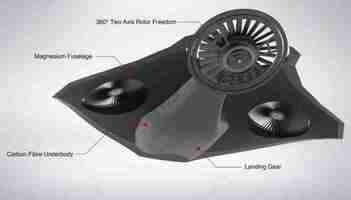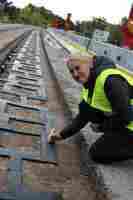How high-end cameras and algorithms are making escooters safer
This article was originally published by Christopher Carey on Cities Today , the leading news platform on urban mobility and innovation, reaching an international audience of city leaders. For the latest updates follow Cities Today on Twitter , Facebook , LinkedIn , Instagram , and YouTube , or sign up for Cities Today News.

Swedish micromobility firm Voi is adding computer vision technology to its e-scooters to automatically reduce speeds when they enter heavily pedestrianized areas.
The firm has partnered with Irish tech startup Luna to implement the technology, which comprises high-end camera sensors.
Algorithms interpret input from these sensors, and the data is processed using edge computing – an approach where data crunching is carried out closer to the location it is needed to reduce latency.
The technology will also be able to detect the surface that an e-scooter is being ridden on, such as a bike lane or pavement, and adjust its speed accordingly.
Fredrik Hjelm, Co-Founder and CEO of Voi Technology, said: “We are embracing pioneering technology like this so that we can help shape cities for living, and to ensure that municipal authorities feel confident in including e-scooters as part of their smart city strategies.”
UK trials
Trials of the new solution are currently underway in the UK city of Northampton, and the first phase will see local Voi staff fit scooters with the technology, so they can learn their environment.
Once this phase is complete, the technology will be integrated into Voi’s e-scooters for public use in the city.
Northampton’s e-scooter trial is part of a UK-wide government-led initiative to test the effectiveness of e-scooters in UK cities.
Last week Transport for London (TfL) launched a competition to determine which three e-scooter firms will take part in its trial, set to launch next spring.
Ensuring safety has become a critical feature of the UK trials, with e-scooter firms introducing features like one-second geofencing technology and artificial sounds to warn pedestrians.
UK motoring association The AA has also teamed up with German e-scooter firm TIER Mobility to run road safety lessons , where e-scooter riders will be taught how to operate and park the vehicles and share the road safely with cars, pedestrians , and vulnerable users.
Micromobility safety
While the safety of e-scooters has come under heavy scrutiny in recent years, research by the Organization for Economic Co-operation and Development (OECD) has found they are not any more dangerous than other forms of micromobility, including bicycles and e-bikes.
Earlier this month, the Dutch government successfully piloted a safety feature designed to limit the speed of e-bikes on a four-kilometer stretch of bike lanes at Schiphol airport, Amsterdam.
Using digital technology, the motor of the e-bikes cuts out when the devices enter built-up areas.
The non-profit Townmaking Institute , which is behind the concept, is working with e-bike firms and government authorities with the expectation that the technology could be rolled out by 2022.
Discussions over the use of the technology are most advanced with the municipality of Amsterdam, but the provinces of Gelderland and North Holland are also said to have shown an interest.
The standard e-bike reaches speeds of 20-25 km/h, but faster-advanced models can reach 80 km/h.
In 2019, 65 people were killed while riding e-bikes in the Netherlands, up from 57 in 2018.
SHIFT is brought to you by Polestar. It’s time to accelerate the shift to sustainable mobility. That is why Polestar combines electric driving with cutting-edge design and thrilling performance. Find out how .
Whatever Elon says, Tesla’s not planning to dominate aviation
This week, news resurfaced again of Tesla’s interest in aviation. Given how many stories turn out to be nothing more than rumors, I decided to look into the likelihood of a Tesla aircraft.

So what’s the latest?
Not as much as you might think.
The billionaire entrepreneur shared a post on Twitter, saying he is “working on Master Plan Part 3,” without revealing more details.
In response, Morgan Stanley’s key analyst on all things Tesla, Adam Jonas, asserted in a research note reported by MSN:
How did the Tesla aviation rumors start?
There have been plenty of efforts to link Tesla and the sky. Elon Musk has not been shy in speculating about extending Tesla’s business beyond electric cars, space exploration, hyperloop tunnels, brain implants, and trucks.
Almost everything he says becomes either headline or article fodder and gets shared globally.
But if I was going to pick out a few examples to build an argument for a Tesla aircraft, I’d include:
Elon Musk in 2008 told TechCrunch that “an electric plane only gets more feasible as battery technology improves .”
In Iron Man 2 , Tony Stark walked up to Elon Musk to shake his hand and compliment him about the Merlin engines. Musk smiled and replied, saying he’s got an idea for an electric jet, and Tony says they would make it work.
In 2016, at a Hyperloop Q&A at Texas A&M, Musk shared: “Well, I have been thinking about the vertical takeoff and landing electric jet a bit more. I mean, I think I have something that might be close. I’m quite tempted to do something about it.”
Then, on an episode of Third Row Tesla’s podcast, interviewers asked Elon about his plans to enter aviation in 2020. Elon replied:
“No. I think it’s incredibly difficult to bring an aircraft to production and meet all the regulatory requirements worldwide. It’s a very difficult thing… It takes a massive amount of effort to do any one of these things, so you can’t do them all.”
In 2020 Musk replied to speculation by investor Sam Korus about an electric jet that better battery tech was only three to four years away:
A couple of months later, he again tweeted about the virtues of supersonic jets in response to a tweet from the “World of Engineering” account (since deleted), which commemorated the anniversary of Concorde’s last commercial flight 17 (now 19) years ago.
Is it a Tesla eVTOL?!
In 2021, UK industrial designer Tom Abbot-Davies unveiled an idea for an eVTOL that resembles a futuristic manta ray with the capacity to carry one passenger.


It was all part of a masterful plan to get an internship, and while Elon complimented him on the design, his plan failed to eventuate as he didn’t get the role. Crap.
Then in 2021, Musk again expressed his enthusiasm, but admitted that another project would make his head explode. I feel that way just deciding what cocktail to order at a happy hour, Elon.
A nice idea that is yet to gather speed
So, there you have it, a few tweets and some answers to specific questions. It hardly makes a master plan for a supersonic jet or a Tesla eVTOL !
However, I do think that if Tesla was going to enter the aviation space, it would be in the battery R&D sector. It has been continually developing and expanding the capabilities of Tesla’s batteries in terms of weight, material innovation, and building out the broader charging infrastructure.
So, could we see Tesla batteries in eVTOLs ? Maybe. Could we see specialist Tesla-built charging stations? Possibly.
Even Tesla can’t hurry up the Federal Aviation Authority
I’ve spoken to several VTOL companies , and getting regulated is a long, slow process. The earliest innovators literally helped write the regulations as their tech began to evolve . They have yet to fly people commercially, let alone cargo.
Further, the R&D issue isn’t just a matter of funds.
We know Musk has plenty of cash, but it’s not so easy to find appropriately skilled staff. Even last year’s Tesla AI day was little more than an effort to attract talented graduates and professionals from other industry players.
So while it may seem logical to add aviation to Musk’s space/road/tunnel family, I won’t be holding my breath anytime soon.
Energy harvesting roads turn weird science into commercial applications
ElectReon (Israel)

ElectReon is an Israeli firm developing an in-road inductive charging system.
How it works:
Its charging solution powers EVs from electrical fields generated by copper coils under the asphalt
A management unit transfers the energy from the electricity grid to the road infrastructure and manages communication with approaching vehicles
Receivers are installed on the vehicles’ floor to transmit the energy directly to battery while driving


In December, the company launched an E-bus shuttle, charged by Germany’s first wireless electric road system, which powers a bus line between a training center in Karlsruhe and the local public transport system.
The wireless charging lessens the electrical grid connections needed at bus facilities. It also reduces vehicle battery reliance, size, and weight. Not to mention that charging while on the go brings down fleet vehicle downtime and enables extended operational hours.
Elonroad (Sweden)
Elonroad creates charging infrastructure for all-electric vehicles. It’s both an electric road solution for charging while driving and an automatic park charger without cables. It works in cities, highways, parking spaces, and taxi lines.
The company mounts conductive power strips on top of roads. A conductive pick-up under the vehicle connects to the electric rail, creating bus stop charging and in-motion charging for vehicles with access permission through a wireless system.
Then, the road connects to a server that identifies each vehicle. The energy delivered from each segment is measured, and the energy provider bills the right amount to each customer.
Underground Power (Italy)
Underground Power is an Italian company that creates smart speed bumps. Tire-like rubber paving converts the kinetic energy produced by moving vehicles into electric energy.
This helps cars respect the speed limits and retrieves the kinetic energy wasted during the deceleration.